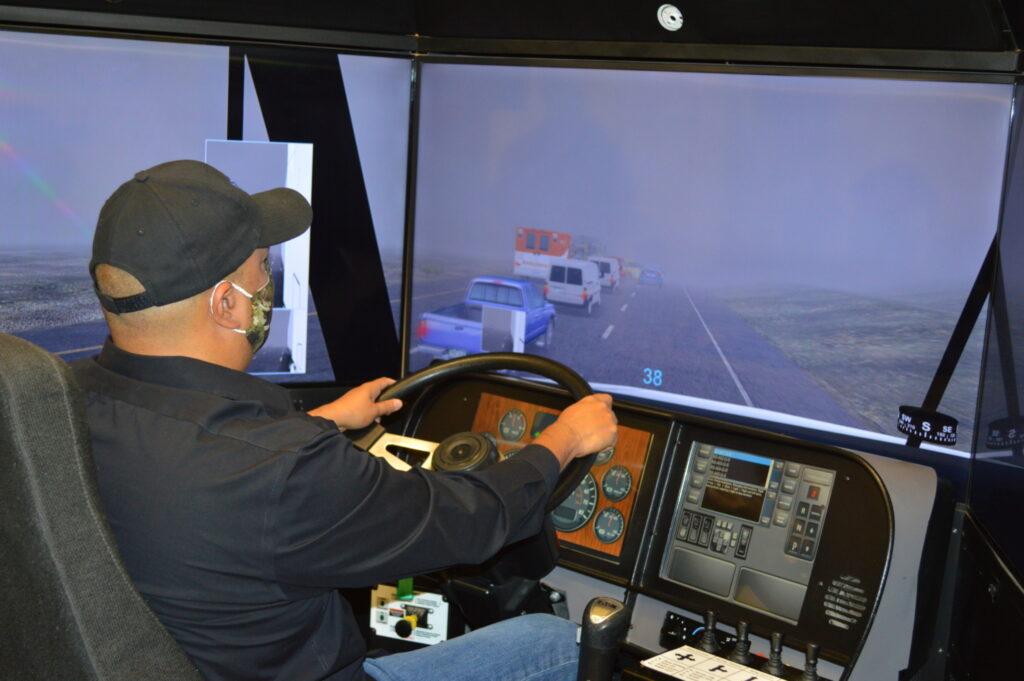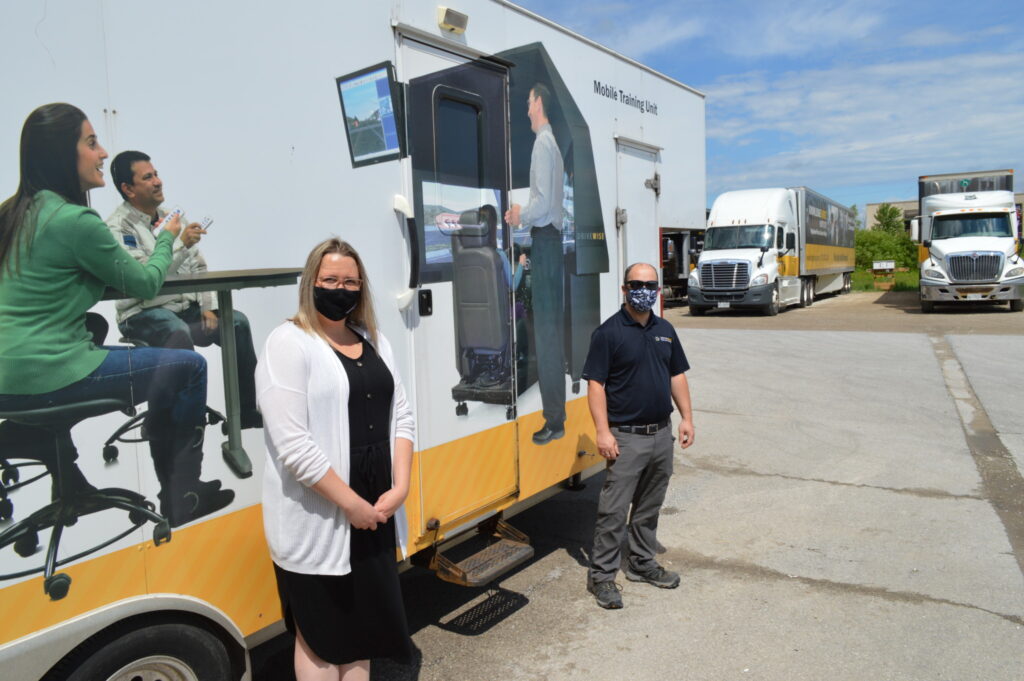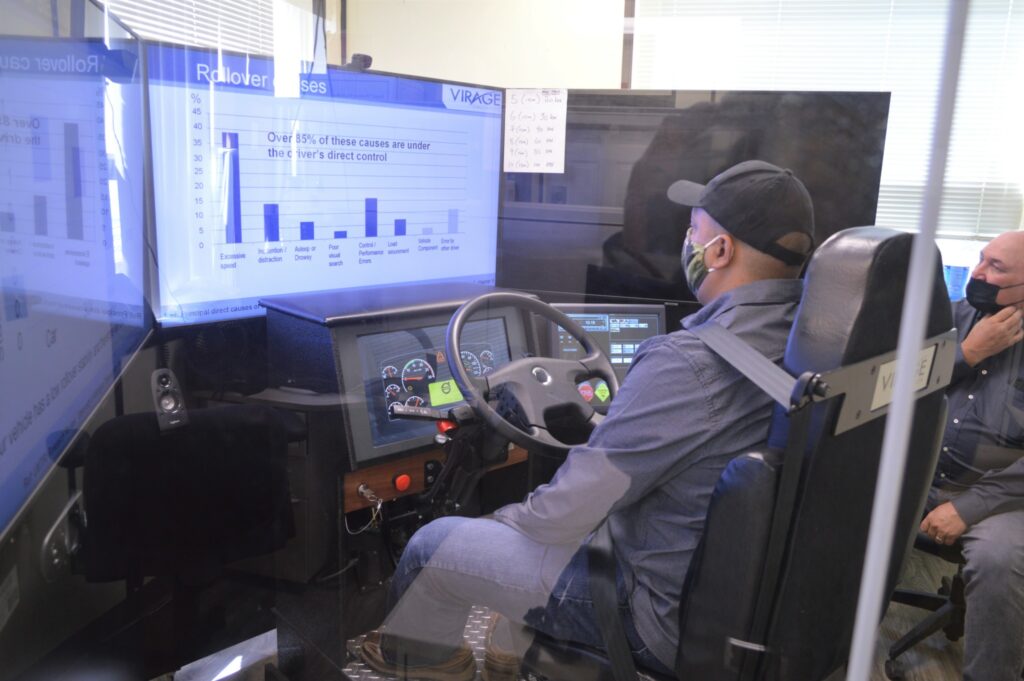Simulators offer safety, training benefits
It felt good getting behind the wheel and hearing the roar of the engine, especially after being stuck at a desk for so many months.
Rolling down an empty highway hauling a trailer at night was a piece of cake, although changing weather conditions and the odd deer kept me on my toes. As I pulled into a city street with impatient four-wheelers and pedestrians peering into their phones, things got a little more challenging.

I encountered construction, the street ahead was closed off, and I was forced to make a right turn. I should have been more patient, but the light was green, and I attempted to take the turn. I got stuck! There wasn’t enough room.
I had to perform a blind-side backing maneuver at a busy intersection to get out of the mess I had got myself into.
In the real world, it would be a nightmarish situation. But with a flick of switch, all my troubles vanished. Practicing with pixels is very forgiving.
I was using a simulator at DriveWise in Barrie, Ont. The facility provides a safe place for training novice and experienced drivers. The simulator was extremely responsive and took a little getting used to.
I was keen on stepping up my simulator experience and decided to try hauling a tanker. I have never done so in real life.
Commercial Heavy Equipment Training (CHET) in Mississauga, Ont., offers a tanker simulation program, and they let me take a spin at the wheel.
Pulling a liquid load is a totally different beast. The surge I felt each time I hit the gas or feathered the brake was not pleasant. It was a constant reminder that thousands of pounds of liquid were sloshing behind me, alive with every movement.
I had to constantly be aware of my speed and position on the road, gently guiding the truck off the highway. The slightest mistake on the ramp due to the high center of gravity along with a liquid load, could cause a rollover.
On city streets, I had to be extra careful due to numerous stops and starts. And I did not do well. I ran over curbs and in one instance the back wheels crushed a traffic light as I made a turn.
Creating a better driver
The simulator experiences drove home the point that training helps create a better driver. I spoke with officials at both facilities about their training, operations, and philosophy.
Matt Davis, director of products and services at DriveWise says the company started offering mobile simulator training when it began operations in 2004.
A unit was taken in a trailer and unloaded at a client’s facility. “In 2010, we had the first unit where the simulator stayed inside the trailer,” Davis says.
At present, all the simulation units are mobile and fit into the trailer.
Philip Fletcher, operations manager at CHET sees the benefit of simulators during training for novice drivers. He says younger drivers are used to technology and this is how they can be attracted to the industry.

“I get very few people under the age of 30 coming for training, but more people in their 30s are enrolling,” Fletcher says. CHET is Musket Transport’s in-house driving school, and some students are hired by the company after getting their commercial driving licence.
Samantha Clarke, DriveWise’s commercial driver solutions manager says each course is customized for the client.
“We do a needs analysis before we go out for the course, and we build into it whatever they want for that course for that day. Sometimes we do half-day courses, sometimes a full-day course and sometimes we are there for a week at a time,” Clarke says.
CHET’s Fletcher says they provide training for manual transmissions. Students complete five lessons on the simulator before they get to the truck.
“We start them off on the simulator. A lot of it is pace and timing, in getting them used to the double clutch. We work on that on the simulator before we go out on the road,” he says.
“In that way we have overcome a lot of the problems they are going to experience early on. We are more worried about observation skills when they get on the road. We are trying to build muscle memory.”
He says the simulator takes the fear and anxiety out of students before they get into a truck. If a student is not progressing, simulator training is extended, because it is cheaper than going out on the road, and safer.
Davis says DriveWise built the first simulator on site in 2008 for the novice driver market. He says at present 20 to 30 simulators are built a year, whenever orders are received.

Clarke says pricing depends on many factors, including size and applications.
“For a trucking simulator, the starting price is about $100,000,” Davis says.
Fletcher says the devices are worth every cent. “From 2019 to 2020, our accident rate came down to less than one accident per million miles traveled across North America.”
He says during the same timeframe, the turnover rate of drivers at Musket Transport dropped to less than 10%.
Davis says he is working on a snowplow simulator for a company in Alberta. DriveWise also provides training for the military, police, firefighters, emergency medical services, trucking companies, and fleets like Canada Post and FedEx.
Virtual reality
CHET is working with virtual reality company iMVR to provide VR training for tankers.
Fletcher says, “With VR you can record, capture and replay certain segments during the lesson. What could you have been doing differently, what you should have been looking at.”
“We have eye tracking with VR. We can ask the student, ‘Why are you looking there, why did you look there that long, why are you not looking here?’”
The CHET operations manager is also trying to get eye tracking on the simulator too. “It will help a lot,” he says.

Fletcher is keen on installing facial recognition software on the simulators. “It will tell me what the person is experiencing in terms of emotional responses to the training. What is working well, what’s not working well.”
CHET is working with McMaster Digital Research Training Centre on facial recognition technology that Fletcher hopes to get sent over for a pilot project.
Practicing on simulators offered an insight into my abilities and limitations, and what I should focus on. Worst-case scenarios provided useful training for situations that I could encounter on the road.
As technology improves, the experience is going to increasingly align with real-life situations. The result will be safer roads for everyone.
Have your say
This is a moderated forum. Comments will no longer be published unless they are accompanied by a first and last name and a verifiable email address. (Today's Trucking will not publish or share the email address.) Profane language and content deemed to be libelous, racist, or threatening in nature will not be published under any circumstances.